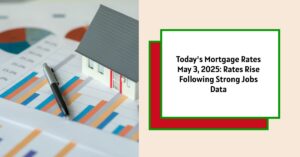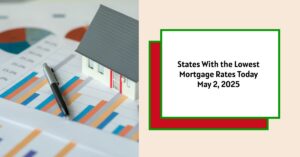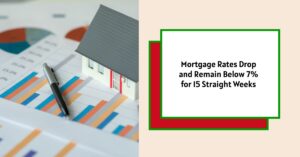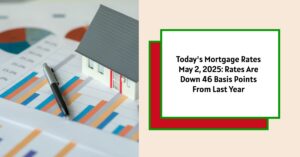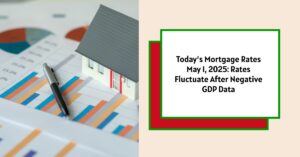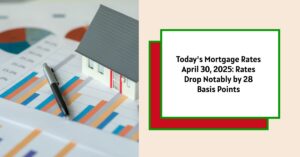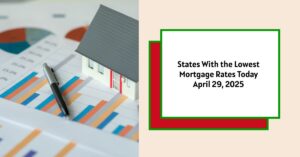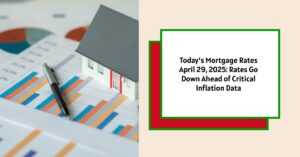As of May 3, 2025, mortgage rates have experienced a noticeable increase, primarily in response to a recent strong jobs report. The average 30-year fixed mortgage rate has risen to 6.70%, reflecting a nine basis point hike since the previous reporting period. If you've been considering purchasing a home or refinancing, you may be wondering how these changes affect your options.
Today's Mortgage Rates – May 3, 2025: Rates Rise Following Strong Jobs Report
Key Takeaways
- Current Mortgage Rates: 30-year fixed at 6.70%, 15-year fixed at 5.95%.
- Refinance Rates: 30-year refinance rate now 6.75%.
- Impact of Jobs Report: Higher employment figures correlate with rising rates.
- Market Trends: Economists predict that while rates are currently higher, a gradual decline may occur by the end of 2025.
The fluctuation in mortgage rates not only influences individual borrowers but also reflects broader economic conditions. Factors such as employment rates, inflation, and the state of the economy play critical roles in shaping these rates.
Current Mortgage Rates
The table below outlines the national average mortgage rates for various loan types as of May 3, 2025, based on the latest data from Zillow.
| Loan Type | Current Rate |
|---|---|
| 30-Year Fixed | 6.70% |
| 20-Year Fixed | 6.28% |
| 15-Year Fixed | 5.95% |
| 5/1 ARM | 6.88% |
| 7/1 ARM | 7.13% |
| 30-Year VA | 6.24% |
| 15-Year VA | 5.66% |
| 5/1 VA | 6.32% |
Today's Mortgage Refinance Rates
The table below presents the current average refinance rates, also sourced from Zillow:
| Refinance Type | Current Rate |
|---|---|
| 30-Year Fixed | 6.75% |
| 20-Year Fixed | 6.49% |
| 15-Year Fixed | 6.08% |
| 5/1 ARM | 7.37% |
| 7/1 ARM | 7.47% |
| 30-Year VA | 6.33% |
| 15-Year VA | 6.07% |
| 5/1 VA | 6.43% |
Understanding the Rate Changes
In recent weeks, mortgage interest rates have generally moved upward, influenced by stronger-than-anticipated job growth as evidenced by the latest jobs report. According to reports, while the unemployment rate remains stable, the addition of more jobs suggests a robust economy. As a result, banks and lenders often increase mortgage rates in response to positive economic indicators. This trend can make borrowing more expensive at a time when buyers may initially hope for lower rates.
The Psychology of Rate Changes
The psychological impact of rising mortgage rates cannot be overlooked. Buyers tend to perceive increasing rates as a signal that now is the last chance to act before they rise even further. This sentiment can lead to a rush in home purchases, which can push prices up even more in the short term. Conversely, when rates are falling, potential buyers may delay their purchases, waiting for even lower rates. Such behaviors create fluctuations in demand that can significantly affect housing prices.
Furthermore, the terminology used to discuss rates plays a role in public perception. For instance, when rates decrease by a fraction, it often results in increased buyer interest. However, when rates rise—even slightly—it can lead to hesitation among potential buyers who fear that they may be priced out of the market or end up with a less favorable mortgage deal.
Factors Influencing Mortgage Rates
- Economic Indicators: Mortgage rates react to overall economic health. Positive indicators can increase rates, as lenders anticipate potential inflation. Conversely, economic downturns may lower rates as lenders seek to stimulate borrowing. Key indicators to watch include employment data, inflation rates, and consumer spending patterns.
- Federal Reserve Policy: The Federal Reserve's decisions on interest rates directly impact mortgage rates. They utilize monetary policy to maintain economic stability, adjusting rates in response to inflation or unemployment levels. When the Fed raises the federal funds rate, it increases borrowing costs, ultimately affecting mortgage rates.
- Treasury Yields: The yield on 10-year Treasury notes is closely tied to mortgage rates. When investors buy Treasury securities, their yields decrease, leading to lower mortgage rates. Conversely, rising yields signal increasing rates. This relationship highlights how financial markets react to global events, such as pandemics or geopolitical tensions, impacting investor risk appetite.
- Market Conditions: Supply and demand dynamics in the housing market can also sway mortgage rates. Significant home demand can lead to increased rates as lenders capitalize on competition. Conversely, if inventory increases without corresponding demand, rates may stabilize or even decrease.
- Political Climate: Political events, including elections and policy changes, can also impact mortgage rates. For example, proposed regulations affecting lending standards or housing developments can create uncertainty, influencing lenders’ decisions about rate adjustments.
- Global Economic Factors: Global events and economic ties significantly affect domestic markets. Natural disasters, international trade negotiations, or conflicts can lead to unpredictability in financial markets, pushing rates up or down based on investor confidence in economic stability.
Types of Mortgages Available
It's essential to thoroughly understand the options available in today's market. Here’s a closer look at each type of mortgage, their pros and cons:
30-Year Fixed Mortgage Rates
The 30-year fixed mortgage is a long-term option that allows borrowers to lock in a consistent interest rate over a three-decade period.
- Pros:
- Predictable Payments: Monthly payments remain consistent, helping with budgeting.
- Lower Monthly Payments: Spreading repayments over a longer period results in lower monthly costs.
- Cons:
- Higher Interest Payments: Over a 30-year term, borrowers pay significantly more interest compared to shorter terms.
- Long-Term Commitment: 30 years is a long time; life circumstances may change, impacting your financial situation.
15-Year Fixed Mortgage Rates
The 15-year fixed mortgage offers a shorter repayment option, resulting in significant interest savings.
- Pros:
- Lower Interest Rates: Generally, interest rates on shorter loans are lower.
- Faster Equity Building: Pay off the loan quicker, allowing greater ownership sooner.
- Cons:
- Higher Monthly Payments: A compressed repayment period results in heftier payments, which can strain budgets.
- Less Flexibility: Higher payments may limit financial flexibility for other expenses.
Adjustable-Rate Mortgages (ARMs)
ARMs typically feature an initial lower interest rate that adjusts after a specified period.
- Pros:
- Lower Initial Payments: Typically start lower than fixed-rate mortgages, making homeownership more accessible initially.
- Potential Savings: If you move before rates adjust, you can benefit from lower payments without long-term commitment.
- Cons:
- Unpredictable Rates: Post-initial period, rates can significantly increase, making budgeting challenging.
- Risk: Renewing an ARM may lead to unpleasant surprises if market conditions change drastically.
Read More:
Mortgage Rates Trends as of May 2, 2025
When Will the Soaring Mortgage Rates Finally Go Down in 2025?
Why Are Mortgage Rates Rising Back to 7%: The Key Drivers
Mortgage Rate Expectations 2025
Does this current increase imply rates will continue to rise? According to Fannie Mae's Forecast, mortgage rates are expected to stabilize as the economy finds its footing, projecting rates might settle around 6.2% by late 2025. Similarly, Freddie Mac's Housing and Mortgage Market Outlook suggests that while rates are presently higher, the market may respond by gradually cooling down. However, the projections are not without their uncertainties.
Experts note that despite projections of potential decreases, several factors could complicate the situation. For instance, persistent inflation or geopolitical tensions could prevent significant drops in rates, causing borrowers to remain cautious.
Are We in a Good Market to Buy a Home?
Despite higher mortgage rates, the housing market presents opportunities, particularly when compared to previous years when prices surged dramatically. With rates higher than in earlier periods, immediate buying decisions should reflect individual needs rather than predictions of rate changes.
Timing the Market
While it’s tempting to try and time the perfect moment to buy, few can successfully predict market fluctuations consistently. Buyers should consider their personal financial situations, how long they plan to stay in the home, and other factors unique to their circumstances.
Some prospective buyers may find themselves in a good position despite the rising rates if they can find a reasonably priced home in their desired area. Financing options such as first-time homebuyer programs or state-sponsored assistance programs can also ease the burden for many buyers.
In summary, from today's mortgage rates showing a tangible increase to the longer-term expectations that hint at moderation, the mortgage landscape can seem daunting. However, with informed choices and an understanding of individual financial goals, navigating these waters becomes achievable. Mortgage rates, driven by fluctuating economic conditions, pose a complex picture impacting both current homeowners and prospective buyers similarly.
By staying informed and actively researching the market, borrowers can better position themselves for negotiation and make decisions that best suit their needs in the context of the changing financial landscape.
Turnkey Real Estate Investment With Norada
Investing in real estate can help you secure consistent returns with fluctuating mortgage rates.
Despite softer demand, smart investors are locking in properties now while competition is lower and rental returns remain strong.
HOT NEW LISTINGS JUST ADDED!
Speak with an investment counselor (No Obligation):
(800) 611-3060
Also Read:
- Will Mortgage Rates Go Down in 2025: Morgan Stanley's Forecast
- Expect High Mortgage Rates Until 2026: Fannie Mae's 2-Year Forecast
- Mortgage Rate Predictions 2025 from 4 Leading Housing Experts
- Mortgage Rates Forecast for the Next 3 Years: 2025 to 2027
- 30-Year Mortgage Rate Forecast for the Next 5 Years
- 15-Year Mortgage Rate Forecast for the Next 5 Years
- Why Are Mortgage Rates Going Up in 2025: Will Rates Drop?
- Why Are Mortgage Rates So High and Predictions for 2025
- Will Mortgage Rates Ever Be 3% Again in the Future?
- Mortgage Rates Predictions for Next 2 Years
- Mortgage Rate Predictions for Next 5 Years
- Mortgage Rate Predictions: Why 2% and 3% Rates are Out of Reach
- How Lower Mortgage Rates Can Save You Thousands?
- How to Get a Low Mortgage Interest Rate?
- Will Mortgage Rates Ever Be 4% Again?
